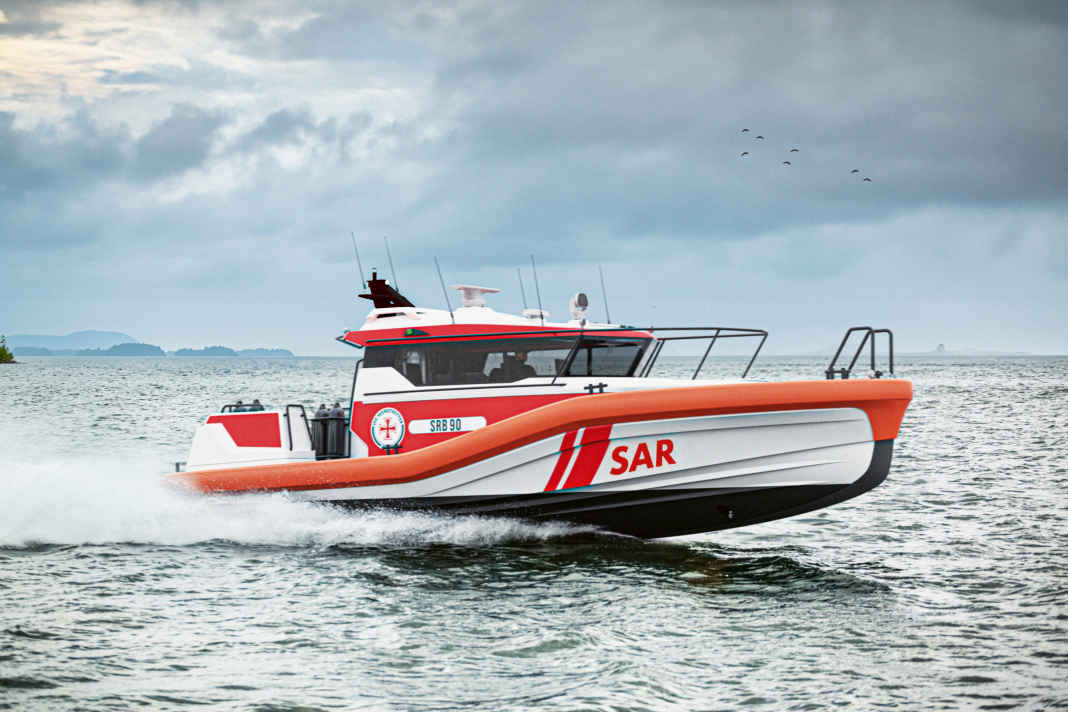


The German Maritime Search and Rescue Service (DGzRS) is pressing ahead with the modernisation of its fleet. The sea rescuers have commissioned the construction of a prototype for a completely new class of sea rescue boat. The special vessel, which is a good twelve metres long and can travel at speeds of up to 34 knots, is due to be delivered to the DGzRS in 2026. The sea rescuers will then extensively test the new vessel at various stations in the North Sea and Baltic Sea. With the innovative design, the sea rescuers are responding to the upcoming generation change in their 9.5/10.1 metre class fleet.
More about the proven 9.5/10.1 metre class of sea rescue boats:
Innovative requirements for greater efficiency
During the development of the new rescue boat class, the DGzRS formulated three essential additional requirements. In addition to the features typical of all DGzRS units, such as self-righting capability, high seaworthiness and operational capability on the open sea and in shallow water areas close to the coast, the drive train is to be separated from the wheelhouse. This should create even quieter working conditions for the crew and facilitate the handling of the salvage stretcher. State-of-the-art communication and navigation systems that are simple and intuitive to operate are also planned. Another focus is on improved manoeuvrability and significantly higher speed, without reducing the usual high level of seaworthiness.
Technical innovations for more performance
After intensive project work, the DGzRS has concluded a shipbuilding contract with Arctic Boats Oy from Finland based on their design. A twin-jet propulsion system with proven Cummins engines is to provide a maximum speed of more than 30 knots and a cruising speed of over 25 knots, depending on the weather and sea conditions. Both drive trains can be operated completely independently of each other (full redundancy). Dual water jet propulsion systems also improve manoeuvrability in all conditions.
Innovative materials for more flexibility
Another innovation concerns the material: the new type of lifeboat is made of glass and carbon fibre reinforced plastic (GRP/CFRP). According to the DGzRS, the material is also robust compared to the aluminium used previously, but is even lighter, cheaper to build and maintain and easier to process and maintain. Another advantage is that it allows all rooms on board to be designed completely freely. The deckhouse is also fully elastically mounted to further reduce noise in the wheelhouse. For the first time, sprung seats are provided for the entire crew.
Optimised equipment for efficient rescue operations
In terms of the interior design, the DGzRS is relying on tried-and-tested concepts with targeted improvements. There will still be a room in the foredeck to care for shipwrecked persons and provide medical treatment. There will be plenty of open space on deck to store and safely handle rescue equipment. Shipwrecked persons are rescued directly from the water via a low-lying rescue platform at the stern. The all-round fender system will be accessible. Various line systems secure the sea rescuers when working on deck. A positioning system will automatically hold the new lifeboat in place. This allows the foreman to switch from the inside to the outside manoeuvring station, for example when rescuing from the water or manoeuvring on a distressed vessel or in port.
Testing and outlook
Initially, a prototype will be built under the DGzRS internal registration number SRB 90 by Arctic Boats Oy in collaboration with Boomeranger Boats (hull lamination) and WD Steelworks (equipment) in Finland. A capsize test is planned for spring 2026. The new lifeboat will then be extensively trialled at many DGzRS stations in the North Sea and Baltic Sea. If all trials are successful, series production is planned. With the new type of rescue boat, the DGzRS is preparing for the upcoming generation change in its fleet. In the foreseeable future, the first units of the tried and tested 9.5/10.1 metre class, which were put into service between 1999 and 2002, will reach 30 years of service, after which they will be replaced on a regular basis. There are currently more than 30 lifeboats of three generations of this extremely seaworthy, robust and manoeuvrable specialist vessel in service.
Technical specifications of the prototype:
- Length: 12.75 metres
- Width: 4.18 metres
- Draught: 0.76 metres
- Displacement: 11.5 tonnes
- Power: 2 x 425 hp on jets
- Speed: 34 knots
- Type: Double jet drive
- Engines: Cummins
- Maximum speed: over 30 knots
- Cruising speed: a good 25 knots
- Hull and superstructure: Glass and carbon fibre reinforced plastic (GRP/CFRP)
- Glazing: Special safety glass
- Deckhouse: Fully elastically mounted
- Seats: Suspended for the entire crew
- Recovery platform: Low-lying at the rear
- Fender system: All-round and accessible
- Positioning system: Automatic

